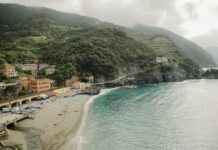The Ile-de-France prefecture has placed Paris, Hauts-de-Seine, Seine-Saint-Denis and Val-de-Marne on «drought» vigilance, thus joining all the other metropolitan departments, already concerned.
A drought that is getting worse as France experiences its third heat wave in barely two months, making the consequences of global warming even more noticeable.
«A heat wave episode is confirmed for the middle of the week, centered on Wednesday and Thursday with maximum temperatures between 34 to 38 ° C and locally 40 ° C», said Monday evening Météo-France.
As a result, four departments in the South-East (Ardèche, Drôme, Gard and Vaucluse) and the Pyrénées-Orientales remain on orange alert.
Fifty other departments, south of a line from Charente-Maritime to Alsace, are on yellow alert.
“On Wednesday, a peak of heat is expected with maximum temperatures most often reaching 34 to 38 ° C, and locally 39 to 40 ° C over the Toulouse noon”, specifies Météo-France, before the hot axis shifts Thursday to the northeast.
In this context, already conducive to unprecedented forest fires, a fire ravaged Monday «at least 200 hectares» of maquis in the town of Santo-Pietro di Tenda in Haute-Corse, a spokesperson told AFP. firefighters.
Another illustration of the negative consequences, the Ardèche announced on Monday the emergency installation of six air conditioners in a children’s home in Privas, where «reigns for weeks» a «stifling heat», according to a press release from the community.
– Soil drying –
This new heat wave promises to be shorter and less intense, specifies Météo-France, than that of mid-July, during which absolute records were beaten in 64 municipalities, flirting or even exceeding 40°C in several localities.
But this rapid return of high heat has hit a major part of the country already affected by an exceptional drought and with immediate consequences, in particular on agriculture, river transport and water recreation.
Only 9.7 millimeters of aggregate precipitation was recorded in mainland France last month, a deficit of about 84% compared to normal, almost as little as the 7.8 mm of March 1961, the record low since the first national surveys in August 1958.
«This strong deficit of precipitation, which follows a very dry spring and combined with high temperatures, contributes to aggravate the drying of the soil», warns Meteo-France.
If the whole of France is now under «drought» vigilance with water restrictions at different levels, 57 prefectures have designated territories in a state of crisis, synonymous with stopping non-priority withdrawals «including withdrawals from agricultural purposes».
«Only withdrawals to ensure the exercise of priority uses are authorized (health, civil security, drinking water, sanitation)», explains the government’s drought information site, Propluvia.
Western Europe faced a historic drought in July and two heat waves in barely a month, during which devastating forest fires broke out as in Gironde, Spain or Greece.














